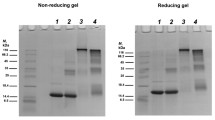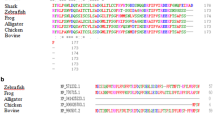Abstract
Loss of eye lens transparency due to cataract is the leading cause of blindness all over the world. While aggregation of lens crystallins is the most common endpoint in various types of cataracts, chaperone-like activity (CLA) of α-crystallin preventing protein aggregation is considered to be important for maintaining the eye lens transparency. Osmotic stress due to increased accumulation of sorbitol under hyperglycemic conditions is believed to be one of the mechanisms for diabetic cataract. In addition, compromised CLA of α-crystallin in diabetic cataract has been reported. However, the effect of sorbitol on the structure and function of α-crystallin has not been elucidated yet. Hence, in the present exploratory study, we described the effect of varying concentrations of sorbitol on the structure and function of α-crystallin. Alpha-crystallin purified from the rat lens was incubated with varying concentrations of sorbitol in the dark under sterile conditions for up to 5 days. At the end of incubation, structural properties and CLA were evaluated by spectroscopic methods. Interestingly, different concentrations of sorbitol showed contrasting results: at lower concentrations (5 and 50 mM) there was a decrease in CLA and subtle alterations in secondary and tertiary structure but not at higher concentrations (500 mM). Though, these results shed a light on the effect of sorbitol on α-crystallin structure–function, further studies are required to understand the mechanism of the observed effects and their implication to cataractogenesis.






Similar content being viewed by others
Abbreviations
- AR:
-
aldose reductase
- CD:
-
circular dichroism
- CLA:
-
chaperone-like activity
- DSC:
-
differential scanning calorimetry
References
Pascolini, D., and Mariotti, S. P. (2012) Global estimates of visual impairment: 2010, Br. J. Ophthalmol., 96, 614-618, https://doi.org/10.1136/bjophthalmol-2011-300539.
Congdon, N. G., Friedman, D. S., and Lietman, T. (2003) Important causes of visual impairment in the world today, JAMA, 290, 2057-2060, https://doi.org/10.1001/jama.290.15.2057.
Asbell, P. A., Dualan, I., Mindel, J., Brocks, D., Ahmad, M., et al. (2005) Age-related cataract, Lancet, 365, 599-609, https://doi.org/10.1016/S0140-6736(05)17911-2.
Drinkwater, J. J., Davis, W. A., and Davis, T. M. E. (2019) A systematic review of risk factors for cataract in type 2 diabetes, Diabetes Metab. Res. Rev., 35, e3073, https://doi.org/10.1002/dmrr.3073.
International Diabetes Federation (2019) IDF Diabetes Atlas 2019, 9th Edn., World Health Organisation, URL: https://diabetesatlas.org/upload/resources/material/20200302_133351_IDFATLAS9e-final-web.pdf.
Wistow, G. J., and Piatigorsky, J. (1988) Lens crystallins: The evolution and expression of proteins for a highly specialized tissue, Annu. Rev. Biochem., 57, 479-504, https://doi.org/10.1146/annurev.bi.57.070188.002403.
Reddy, G. B., Kumar, P. A., and Kumar, M. S. (2006) Chaperone-like activity and hydrophobicity of alpha-crystallin, IUBMB Life, 58, 632-641, https://doi.org/10.1080/15216540601010096.
Reddy, V. S., and Reddy, G. B. (2016) Role of crystallins in diabetic complications, Biochim. Biophys. Acta, 1860, 269-277, https://doi.org/10.1016/j.bbagen.2015.05.009.
Srinivas, P. N., Reddy, P. Y., and Reddy, G. B. (2008) Significance of alpha-crystallin heteropolymer with a 3 : 1 alphaA/alphaB ratio: Chaperone-like activity, structure and hydrophobicity, Biochem. J., 414, 453-460, https://doi.org/10.1042/BJ20080544.
Kumar, P. A., and Reddy, G. B. (2009) Modulation of alpha-crystallin chaperone activity: A target to prevent or delay cataract? IUBMB life, 61, 485-495, https://doi.org/10.1002/iub.176.
Horwitz, J. (2003) Alpha-crystallin, Exp. Eye Res., 76, 145-153, https://doi.org/10.1016/s0014-4835(02)00278-6.
Yan, H., Harding, J. J., Hui, Y. N., and Li, M. Y. (2003) Decreased chaperone activity of alpha-crystallin in selenite cataract may result from selenite-induced aggregation, Eye, 17, 637-645, https://doi.org/10.1038/sj.eye.6700419.
Kelley, M. J., David, L. L., Iwasaki, N., Wright, J., and Shearer, T. R. (1993) alpha-Crystallin chaperone activity is reduced by calpain II in vitro and in selenite cataract, J. Biol. Chem., 268, 18844-18849.
Kumar, P. A., Suryanarayana, P., Reddy, P. Y., and Reddy, G. B. (2005) Modulation of alpha-crystallin chaperone activity in diabetic rat lens by curcumin, Mol. Vis., 11, 561-568.
Huang, F. Y., Ho, Y., Shaw, T. S., and Chuang, S. A. (2000) Functional and structural studies of alpha-crystallin from galactosemic rat lenses, Biochem. Biophys. Res. Commun., 273, 197-202, https://doi.org/10.1006/bbrc.2000.2924.
Kumar, P. A., Kumar, M. S., and Reddy, G. B. (2007) Effect of glycation on alpha-crystallin structure and chaperone-like function, Biochem. J., 408, 251-258, https://doi.org/10.1042/BJ20070989.
Bloemendal, H., de Jong, W., Jaenicke, R., Lubsen, N. H., Slingsby, C., et al. (2004) Ageing and vision: Structure, stability and function of lens crystallins, Progr. Biophys. Mol. Biol., 86, 407-485, https://doi.org/10.1016/j.pbiomolbio.2003.11.012.
Abraham, E. C., Swamy, M. S., and Perry, R. E. (1989) Nonenzymatic glycosylation (glycation) of lens crystallins in diabetes and aging, Progr. Clin. Biol. Res., 304, 123-139.
Brownlee, M., Vlassara, H., and Cerami, A. (1984) Nonenzymatic glycosylation and the pathogenesis of diabetic complications, Ann. Int. Med., 101, 527-537, https://doi.org/10.7326/0003-4819-101-4-527.
Kumar, M. S., Reddy, P. Y., Kumar, P. A., Surolia, I., and Reddy, G. B. (2004) Effect of dicarbonyl-induced browning on alpha-crystallin chaperone-like activity: Physiological significance and caveats of in vitro aggregation assays, Biochem. J., 379, 273-282, https://doi.org/10.1042/BJ20031633.
Chitra, P. S., Chaki, D., Boiroju, N. K., Mokalla, T. R., Gadde, A. K., et al. (2020) Status of oxidative stress markers, advanced glycation index, and polyol pathway in age-related cataract subjects with and without diabetes, Exp. Eye Res., 200, 108230, https://doi.org/10.1016/j.exer.2020.108230.
Kumar, P. A., and Reddy, G. B (2007) Focus on molecules: Aldose reductase, Exp. Eye Res., 85, 739-740, https://doi.org/10.1016/j.exer.2006.08.002.
Varma, S. D., Kumar, S., and Richards, R. D. (1979) Light-induced damage to ocular lens cation pump: Prevention by vitamin C, Proc. Natl. Acad. Sci. USA, 76, 3504-3506, https://doi.org/10.1073/pnas.76.7.3504.
Thampi, P., Zarina, S., and Abraham, E. C. (2002) alpha-Crystallin chaperone function in diabetic rat and human lenses, Mol. Cell. Biochem., 229, 113-118, https://doi.org/10.1023/a:1017980713089.
Cherian, M., and Abraham, E. C. (1995) Diabetes affects alpha-crystallin chaperone function, Biochem. Biophys. Res. Commun., 212, 184-189, https://doi.org/10.1006/bbrc.1995.1954.
Srinivas, P., Narahari, A., Petrash, J. M., Swamy, M. J., and Reddy, G. B. (2010) Importance of eye lens alpha-crystallin heteropolymer with 3:1 alphaA to alphaB ratio: Stability, aggregation, and modifications, IUBMB Life, 62, 693-702, https://doi.org/10.1002/iub.373.
Snow, A., Shieh, B., Chang, K. C., Pal, A., Lenhart, P., et al. (2015) Aldose reductase expression as a risk factor for cataract, Chem. Biol. Interact., 234, 247-253, https://doi.org/10.1016/j.cbi.2014.12.017.
Pfeifer, M. A., Schumer, M. P., and Gelber, D. A. (1997) Aldose reductase inhibitors: the end of an era or the need for different trial designs? Diabetes, 46 Suppl. 2, S82-S89, https://doi.org/10.2337/diab.46.2.s82.
Suryanarayana, P., Saraswat, M., Petrash, J. M., and Reddy, G. B. (2007) Emblica officinalis and its enriched tannoids delay streptozotocin-induced diabetic cataract in rats, Mol. Vis., 13, 1291-1297.
Akileshwari, C., Raghu, G., Muthenna, P., Mueller, N. H., Suryanaryana, P., et al. (2014) Bioflavonoid ellagic acid inhibits aldose reductase: Implications for prevention of diabetic complications, J. Funct. Foods, 6, 374-383, https://doi.org/10.1016/j.jff.2013.11.004.
Kumar, M. S., Kapoor, M., Sinha, S., and Reddy, G. B. (2005) Insights into hydrophobicity and the chaperone-like function of alphaA- and alphaB-crystallins: An isothermal titration calorimetric study, J. Biol. Chem., 280, 21726-21730, https://doi.org/10.1074/jbc.M500405200.
Das, K. P., and Surewicz, W. K. (1995) Temperature-induced exposure of hydrophobic surfaces and its effect on the chaperone activity of alpha-crystallin, FEBS Lett., 369, 321-325, https://doi.org/10.1016/0014-5793(95)00775-5.
Reddy, P. Y., Giridharan, N. V., and Reddy, G. B. (2012) Activation of sorbitol pathway in metabolic syndrome and increased susceptibility to cataract in Wistar-Obese rats, Mol. Vis., 18, 495-503.
Randazzo, J., Zhang, P., Makita, J., Blessing, K., and Kador, P. F. (2011) Orally active multi-functional antioxidants delay cataract formation in streptozotocin (type 1) diabetic and gamma-irradiated rats, PLoS One, 6, e18980, https://doi.org/10.1371/journal.pone.0018980.
Haque, I., Singh, R., Moosavi-Movahedi, A. A., and Ahmad, F. (2005) Effect of polyol osmolytes on DeltaG(D), the Gibbs energy of stabilisation of proteins at different pH values, Biophys. Chem., 117, 1-12, https://doi.org/10.1016/j.bpc.2005.04.004.
Xie, G., and Timasheff, S. N. (1997) Mechanism of the stabilization of ribonuclease A by sorbitol: Preferential hydration is greater for the denatured then for the native protein, Protein Sci., 6, 211-221, https://doi.org/10.1002/pro.5560060123.
Khan, S. H., Ahmad, N., Ahmad, F., and Kumar, R. (2010) Naturally occurring organic osmolytes: From cell physiology to disease prevention, IUBMB Life, 62, 891-895, https://doi.org/10.1002/iub.406.
Ferreira, L. A., Uversky, V. N., and Zaslavsky, B. Y. (2017) Role of solvent properties of water in crowding effects induced by macromolecular agents and osmolytes, Mol. bioSystems, 13, 2551-2563, https://doi.org/10.1039/c7mb00436b.
Beeley, L. (1983) Assessing new drugs, Practitioner, 227, 1527-1534.
Williamson, J. (2012) Linking diabetic complications to sorbitol oxidation, oxidative stress and metabolic suppression, J. Diab. Metab., 3, 219, https://doi.org/10.4172/2155-6156.1000219.
Cherian, M., and Abraham, E. C. (1995) Decreased molecular chaperone property of alpha-crystallins due to posttranslational modifications, Biochem. Biophys. Res. Commun., 208, 675-679, https://doi.org/10.1006/bbrc.1995.1391.
Plater, M. L., Goode, D., and Crabbe, M. J. (1997) Ibuprofen protects alpha-crystallin against posttranslational modification by preventing protein cross-linking, Ophthalm. Res., 29, 421-428, https://doi.org/10.1159/000268043.
Peluso, G., Petillo, O., Barbarisi, A., Melone, M. A., Reda, E., et al. (2001) Carnitine protects the molecular chaperone activity of lens alpha-crystallin and decreases the post-translational protein modifications induced by oxidative stress, FASEB J., 15, 1604-1606, https://doi.org/10.1096/fj.00-0727fje.
Rajan, S., Horn, C., and Abraham, E. C. (2006) Effect of oxidation of alphaA- and alphaB-crystallins on their structure, oligomerization and chaperone function, Mol. Cell. Biochem., 288, 125-134, https://doi.org/10.1007/s11010-006-9128-4.
Verma, G., Singh, P., and Bhat, R. (2020) Disorder under stress: Role of polyol osmolytes in modulating fibrillation and aggregation of intrinsically disordered proteins, Biophys. Chem., 264, 106422, https://doi.org/10.1016/j.bpc.2020.106422.
Aravindan, S., Chen, S., Choudhry, H., Molfetta, C., Chen, K. Y., et al. (2020) Osmolytes dynamically regulate mutant Huntingtin aggregation and CREB function in Huntington’s disease cell models, Sci. Rep., 10, 15511, https://doi.org/10.1038/s41598-020-72613-3.
Reddy, P. Y., Giridharan, N. V., Balakrishna, N., Validandi, V., Pullakhandam, R., et al. (2013) Increased risk of cataract development in WNIN-obese rats due to accumulation of intralenticular sorbitol, IUBMB Life, 65, 472-478, https://doi.org/10.1002/iub.1163.
Acknowledgments
GBR is supported by grants from the Indian Council of Medical Research, the Department of Biotechnology and the Science & Engineering Research Board, Government of India. Research done at the University of Hyderabad was supported by University Grants Commission (India) through UPE-II and CAS programs, and the Department of Science and Technology (India) through the PURSE and FIST programs. CUK and US are supported by a research fellowship from the Indian Council of Medical Research and VS is supported by a research fellowship from the Council for Scientific & Industrial Research, Government of India.
Author information
Authors and Affiliations
Corresponding author
Ethics declarations
The authors declare no conflicts of interest. All applicable international, national, and/or institutional guidelines for the care and use of animals were followed.
Rights and permissions
About this article
Cite this article
Kumar, C.U., Suryavanshi, U., Sontake, V. et al. Effect of Sorbitol on Alpha-Crystallin Structure and Function. Biochemistry Moscow 87, 131–140 (2022). https://doi.org/10.1134/S0006297922020055
Received:
Revised:
Accepted:
Published:
Issue Date:
DOI: https://doi.org/10.1134/S0006297922020055




